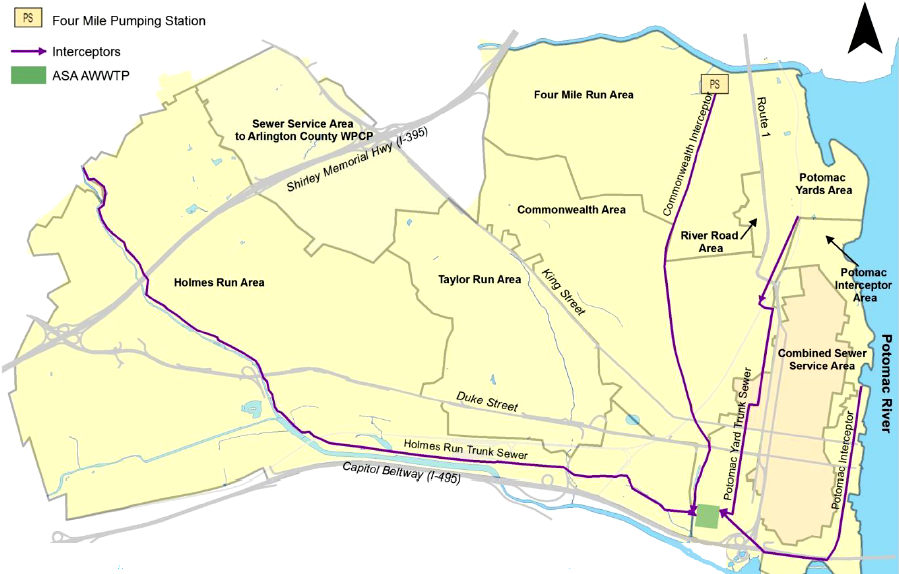
Alexandria sends sewage to both Arlington and the Alexandria Renew Enterprises plant on Cameron Run for treatment
Source: City of Alexandria, Proposed Combined Sewer System Permit Information Meeting & Public Hearing (August 5, 2013)

Alexandria sends sewage to both Arlington and the Alexandria Renew Enterprises plant on Cameron Run for treatment
Source: City of Alexandria, Proposed Combined Sewer System Permit Information Meeting & Public Hearing (August 5, 2013)
Alexandria's first wastewater treatment plant started operations in 1956, processing a maximum of 18 million gallons per day (MGD). Today, the facility on Cameron Run has a 54 MGD design capacity. It could be expanded to handle an additional 12 MGD, but construction within the constrained footprint at the urban site would be very expensive.1
Before construction of the wastewater treatment plant in 1956, many of the city's stormwater and sewage pipes were connected together. There was no obvious need to install separate pipes underground when the system was first constructed, because both stormwater and sewage were sent directly to local streams without treatment. In areas developed after 1956, separate sewage pipes were installed to send the wastewater to the treatment plant.
The stormwater pipes installed after 1956 carry runoff after rainstorms directly to local streams. The stormwater receives no treatment to kill bacteria or improve water quality, though sediment does settle out slightly in stormwater ponds installed to reduce the speed and volume of flows.
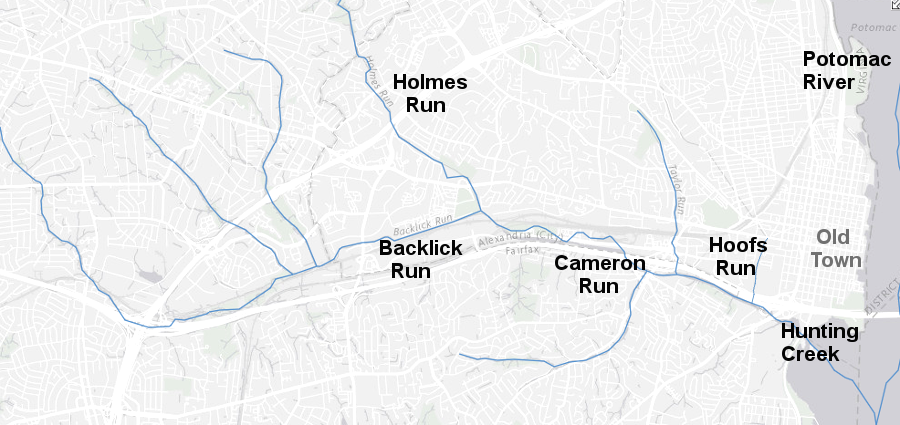
Holmes Run and Backlick Run combine to form Cameron Run, and after Hooff's Run flows into it the combined streams are called Hunting Creek
Source: ESRI, ArcGIS Online
In the combined pipes, during times of low flow the stormwater flows with the sewage wastes together to the wastewater treatment plant. As a result, Alexandria treats some rainwater that flows off rooftops and streets. The sewage waste flushed down toilets and sinks, together with the stormwater in the combined pipes, is processed at the city's wastewater treatment plant. It must meet Virginia Water Quality Standards before the city discharges the treated effluent into Cameron Run.
During storms, the volume of runoff from impervious surfaces exceeds the capacity of the AlexRenew facility and the underground pipes fill up. To prevent water from backing up into toilets and flowing onto bathroom floors, some of the combined stormwater/sewage flows over low-water barriers in the pipes.
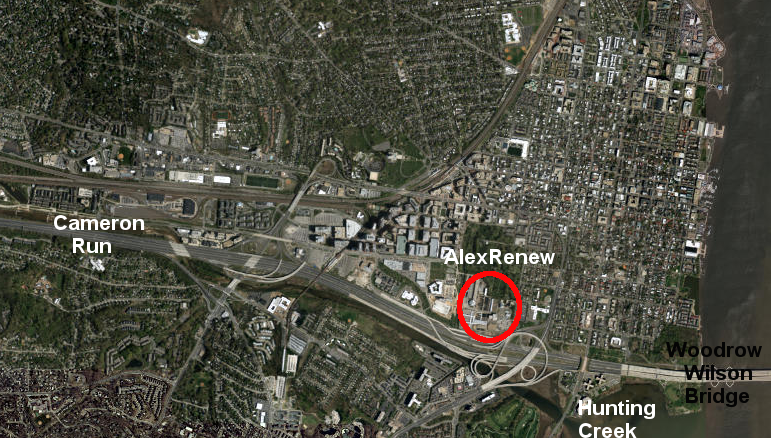
the AlexRenew facility processes combined stormwater/sewage until runoff into the Combined Sewer Overflow system exceeds the plant's capacity
Source: ESRI, ArcGIS Online
The high flows force open gates on the outfalls. Stormwater/sewage is discharged directly into local waterways, and a surge of untreated waste is mixed with high stormwater flows in local streams. The smell can reveal when an outfall gate has been forced open even when the sediment in high stormwater flows obscures the visual clues. After storms pass the volume drops, the low-flow barriers in the pipes then direct the combined stormwater/sewage to the AlexRenew plant, and the outfall gates close.
In 1972, 730 acres in Alexandria were served by combined sewers where stormwater flowed through sewage lines. By 1990, 80% of the original 31 miles of combined sewers had been separated. Eliminating the remaining six miles in Old Town was projected to cost over five times the amount required to eliminate the total previous 25 miles.
Today, 540 acres (6% of the city's area) drains into the combined sanitary/stormwater sewers. Almost all of that area is developed with an impervious surface, so nearly all of the rainwater ends up in the underground system of pipes.2
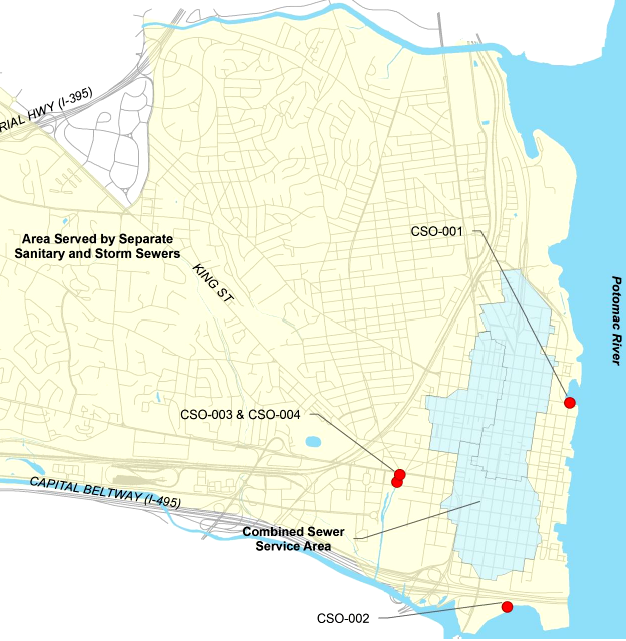
during storms, four outfalls in Alexandria spill combined sanitary waste/stormwater that comes from 540 acres in the city (colored blue, above)
Source: City of Alexandria, Proposed Combined Sewer System Permit Information Meeting & Public Hearing (August 5, 2013)
The city built its system to manage stormwater in order to reduce both flooding and disease. Much of Hooff's Run is now underground, but that stream once was large enough for boats to row from Hunting Creek up to Duke Street.
So much waste used to accumulate in Hooff's Run that it was described as an "Upper King Street Cesspool," in part because during the early 1900's there was a public dumping ground in Rosemont north of the modern King Street Metro station. The storm sewer system that reduced flooding also eliminated stagnant pools that provided habitat for mosquitoes that carried malaria.3
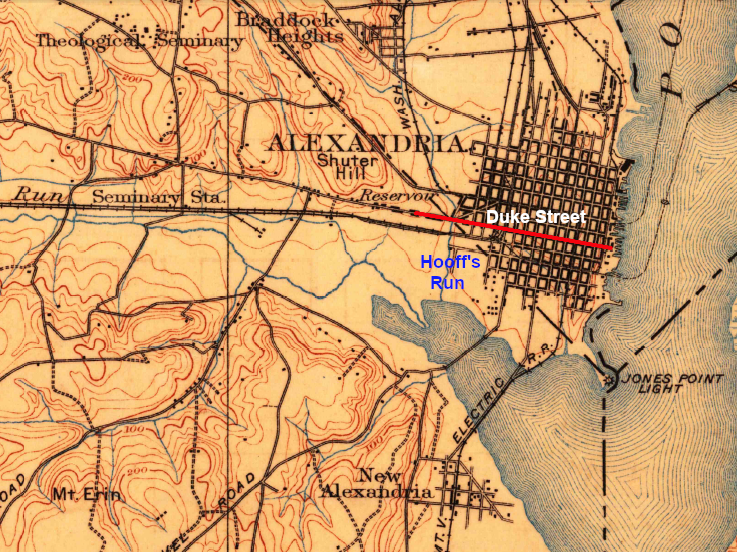
boats could row from Hunting Creek up Hooff's Run to Duke Street
Source: US Geological Survey (USGS), Washington DC 1:62,500 topographic quadrangle (1900)
Alexandria now has four outfalls that spill combined stormwater/sewage during storms. The overflows from three outfalls ultimately reach Hunting Creek, and all four end up polluting the Potomac River.
One (CSO-001) drains into the Potomac River at Oronoco Bay, on the edge of Founders Park near the intersection of Pendleton and Royal streets. One (CSO-002) sends sanitary waste mixed with stormwater directly into Hunting Creek. CSO-003 and CSO-004 drain into Hooff's Run at Duke Street. The discharge from those two outfalls flows down Hooff's Run to its confluence with Cameron Run at the beginning of Hunting Creek.
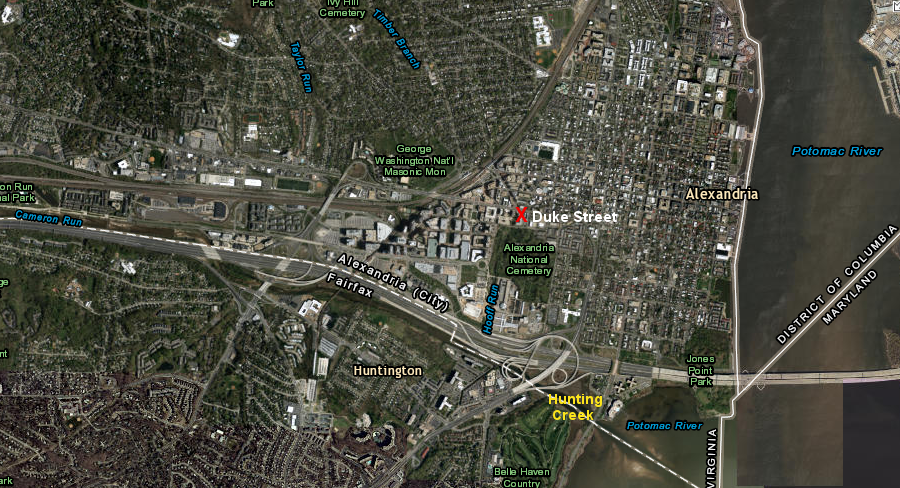
CSO-003 and CSO-004 outfalls at Duke Street (red X) allow untreated sewage to flow into Hooff's Run, then downstream to Hunting Creek
Source: ESRI, ArcGIS Online
CSO-002, CSO-003, and CSO-004 affect water quality of Cameron Run and Hunting Creek. Since 1998, the Virginia Department of Environmental Quality (DEQ) has included Hunting Creek in the list of impaired waters - the 305(b)/303(d) Water Quality Assessment Integrated Report - due to excessively high levels of bacteria. Cameron Creek was added to the "dirty water list" in 2006.
A 2010 report established the Total Maximum Daily Load (TMDL) for Cameron Run and Hunting Creek. To meet Virginia Water Quality Standards, 99% of the bacteria would have to be eliminated from CSO-003 and CSO-004, which discharge initially into Hooff's Run at Duke Street. CSO-002 would have to reduce its contribution of bacteria into Hunting Creek by 80%.4
The TMDL studies themselves do not include action plans with mandates for meeting water quality standards. Instead, the Virginia Department of Environmental Quality uses TMDL studies to craft the city's Virginia Pollutant Discharge Elimination System (VPDES) permit for the Combined Sewer Overflow system. The discharge standards set in the VDPES permit are the legally-enforceable mandates. The permit must be renewed every five years, and the state's requirements for the city to meet water quality standards can change in each new VDPES permit.
The Virginia Department of Environmental Quality was aware of the costs and challenges to retrofit Alexandria's sewage pipes, and the time that would be needed to correct the problem. Discharges of 90% stormwater/10% sanitary waste occur 30 to 60 times/year, and the 2013 VDPES permit authorized the city to continue to send excessive levels of bacteria through the outfalls. The permit did require Alexandria to continue to search for solutions that will ultimately clean up the discharges to meet statewide standards, through its Long Term Control Plan (LTCP).5
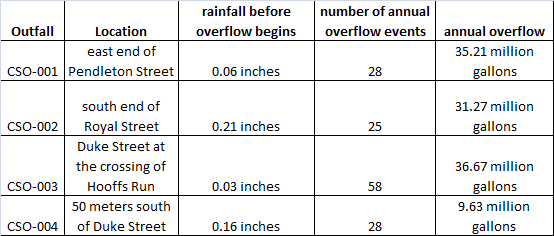
all four outfalls start discharging untreated waste when at least 1/4 inch of rain falls in Alexandria
Source: City of Alexandria, CSS Permit VA0087068 Program Fact Sheet - City of Alexandria

outfalls discharge combined sanitary waste/stormwater for 3.5 hours after a storm
Source: City of Alexandria, Proposed Combined Sewer System Permit Information Meeting & Public Hearing (August 5, 2013)

each of the four outfalls discharges waste at least 45 times a year, on average
Source: City of Alexandria, Proposed Long Term Control Plan Update Summary for the Combined Sewer System
The Alexandria Sanitation Authority was renamed Alexandria Renew Enterprises (AlexRenew) in 2012. The rebranding reflected the city's new perspective that wastewater and stormwater were valuable resources to be managed, not just to be discarded. The wastewater treatment plant was considered to be a water resource recovery facility.
The city initially committed to meet Clean Water Act requirements by implementing "Nine Minimum Controls" in its Long Term Control Plan. The 2013 permit prohibited any discharge from the four CSO outfalls in dry weather, and required an update of the city's 1999 Long Term Control Plan to comply with the Hunting Creek Total Maximum Daily Load (TMDL) maximum for bacteria by 2035.6
The 2016 update to the Long Term Control Plan included a commitment by the city to require separation of sanitary and stormwater pipes as parcels were redeveloped. That approach would result in a gradual reduction of sewage discharges.
By 2018, Alexandria committed to remove up to 92 sanitary sewer connections to the stormwater pipes underneath Payne and Fayette streets. Those 92 pipes with wastewater would be connected instead to the Potomac Yard Trunk Sewer. The city also promised to consider green infrastructure techniques, including green roofs and bioretention systems (rain gardens), to reduce stormwater flows and thus the need to discharge untreated waste.7
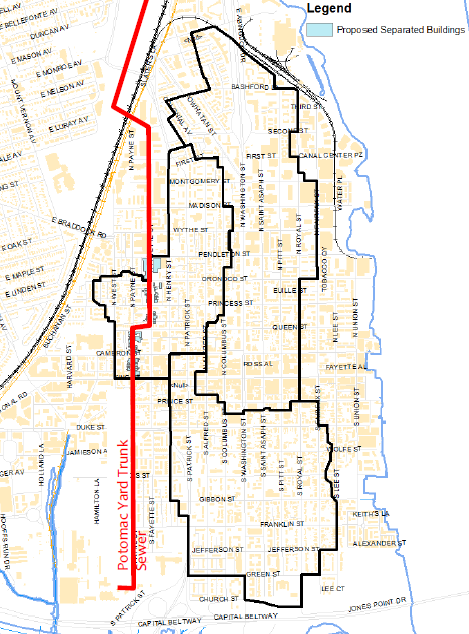
redirecting sanitary connections to the Potomac Yard Trunk Sewer started with a tiny portion (colored in blue) of Old Town Alexandria
Source: City of Alexandria, Proposed Combined Sewer System Permit Information Meeting & Public Hearing (August 5, 2013)
The expensive part of the city's 2016 Long Term Control Plan Update included constructing an underground storage tunnel in the area of Hooff's Run to store flows that otherwise would be released from CSO-003 and CSO-004. The city agreed to drill a 10-foot diameter tunnel in bedrock for 0.5 mile to capture 1.6 million gallons from the surge of stormwater runoff after a storm.
Storing combined rainfall and sewage in a tunnel was not a new idea. Richmond used the same technique. Across the Potomac River, the District of Columbia had committed to building a 13-mile long, $2.6 billion tunnel in bedrock to store combined stormwater/sewage until the Blue Plains facility could treat it.
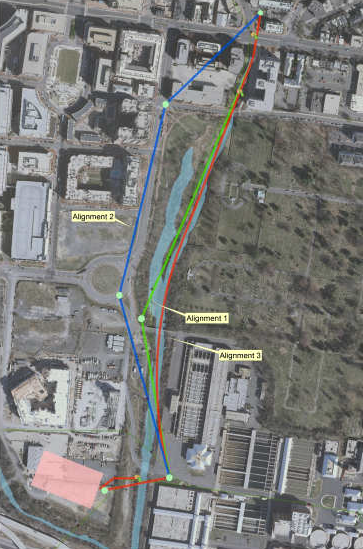
the city chose Alignment 3 for the tunnel to store combined stormwater/sewage
Source: City of Alexandria, Long Term Control Plan Update, Meeting #6 - CSS Stakeholder Group (April 7, 2016)
With the tunnel, Alexandria will be able to store the temporary surges of stormwater/sewage until the Alexandria Renew Enterprises plant on Cameron Run has the capacity to treat the water fully. Without the tunnel, the city would continue to discharge stormwater/sewage during storms through the CSO-003 and CSO-004 outfalls into Hooff's Run, and bacteria levels in Hunting Creek would exceed the Total Maximum Daily Load thresholds.
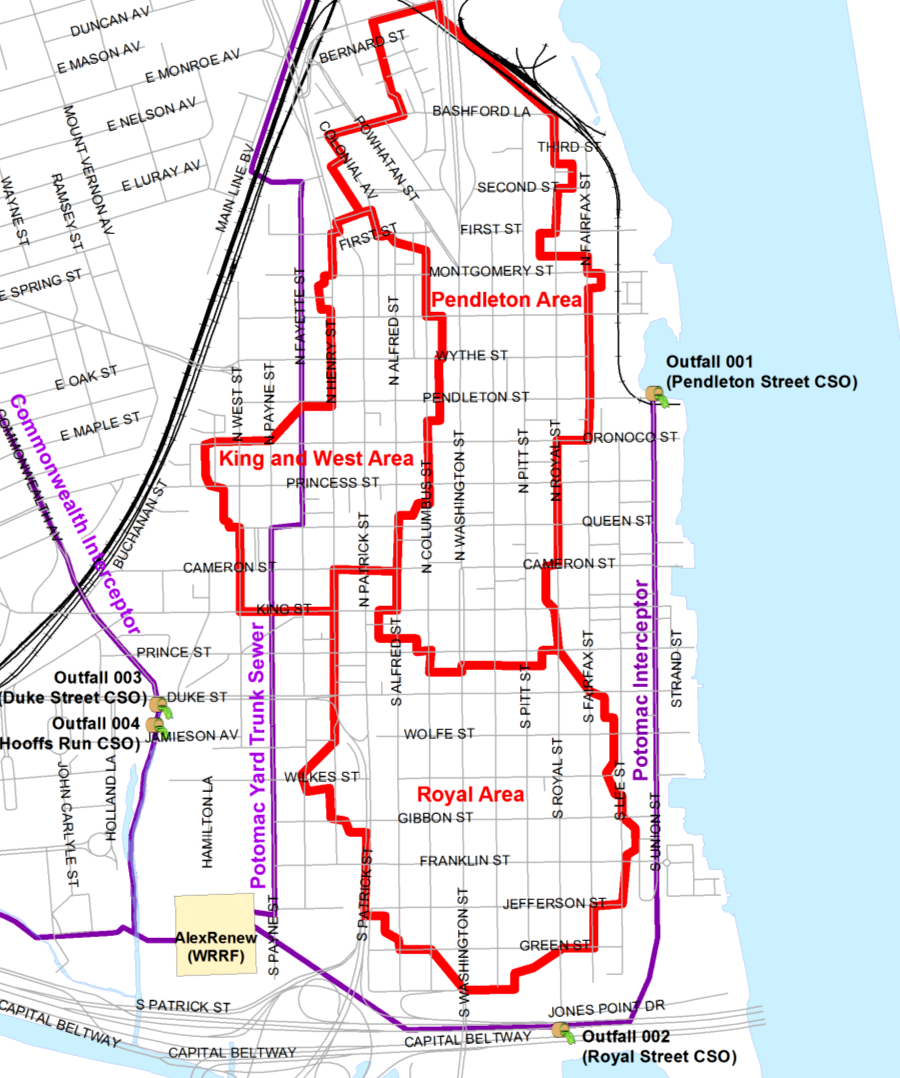
the Combined Sewer Overflow portion of Old Town Alexandria is managed in three zones
Source: City of Alexandria, Proposed Long Term Control Plan Update Summary for the Combined Sewer System
In the 2013 permit, Alexandria also agreed to construct a new above-ground storage tank to capture up to 3 million gallons that otherwise would escape via the CSO-002 outfall into Hunting Creek.
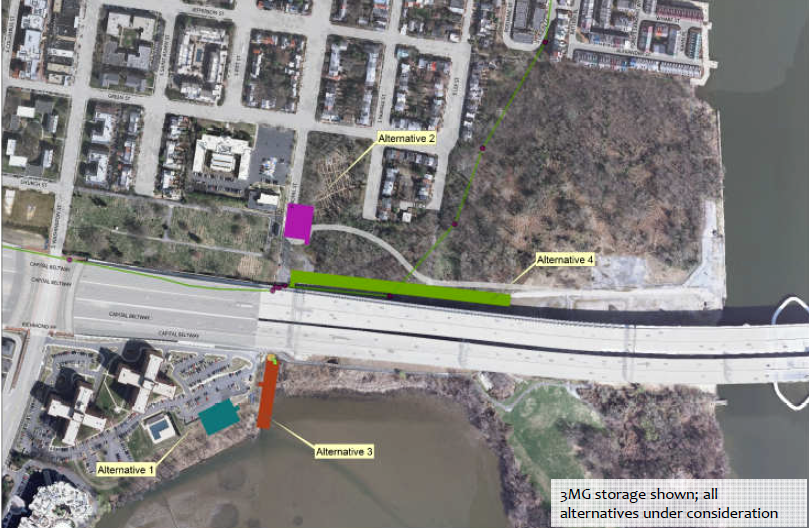
studied four locations next to CSO-002 for the three million gallon storage tank
Source: City of Alexandria, Long Term Control Plan Update, Meeting #6 - CSS Stakeholder Group (April 7, 2016)
The new storage tunnel, storage tank, and other actions will cost up to $188 million. That will require a 20% increase in fees charged to customers.8
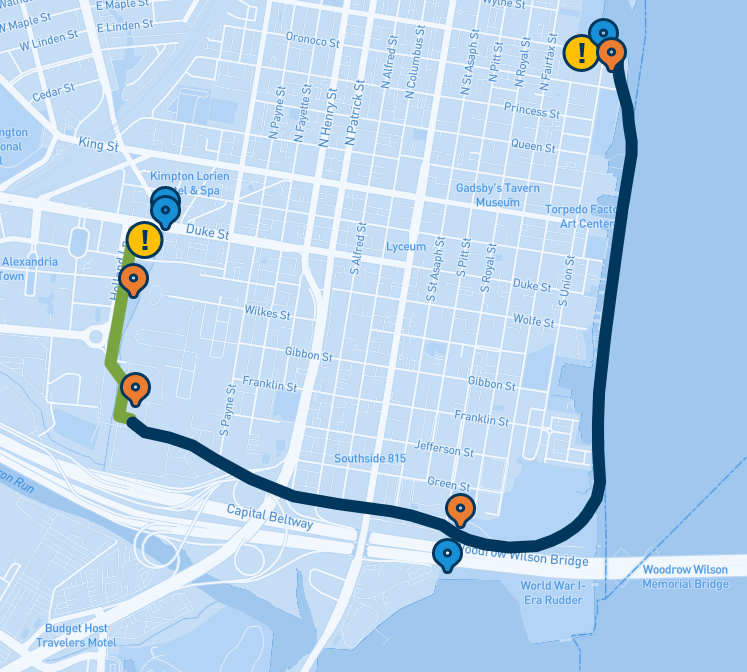
the key engineering decision was to intercept and treat the combined sewage/stormwater, rather than to excavate and separate the pipes in downtown Alexandria
Source: River Renew
The upgrades should reduce the number of overflows from CSO-002, CSO-003 and CSO-004 per year by 96% annually. The new storage will reduce the volume of overflows for CSO-002 by 91%, and for CSO-003 and CSO-004 by 96% - but proposed only a minimal reduction at the CSO-001 outfall on Pendleton Street.
Alexandria did commit to reduce the flow of untreated sewage at CSO-001 by the gradual separation of sanitary connections as redevelopment occurs on different downtown parcels. In addition, new green infrastructure in that outfall's drainage area was proposed to reduce the volume of the discharge.9
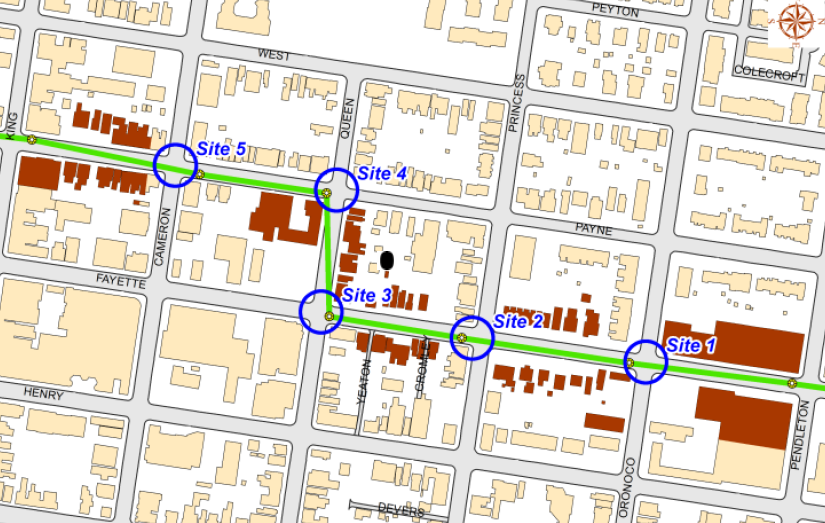
potential buildings for connecting to Potomac Yard Trunk Sewer rather than CSO outfalls
Source: City of Alexandria, Proposed Combined Sewer System Permit Information Meeting & Public Hearing (August 5, 2013)
In the 2013 VDPES permit, the Virginia Department of Environmental Quality allowed the city to delay pollution controls at the CSO-001 outfall until at least the 2018 permit cycle. Building a tunnel or storage tank at CSO-001 to equal the greater-than-90% reductions at the other three outfalls was expected to cost an additional $70-100 million. Reducing combined stormwater/sewage discharges from the other three outfalls were expected to result in sewer bills rising from $45-$60/month to $50-75/month. Additional improvements at CSO-001 would require homeowners in Alexandria to pay another $12.50/month for sewer service.
The 2016 Long Term Control Plan stated that the CSO-001 problem would not be studied further until 2032. After a public uproar, the City Council agreed to accelerate planning by starting a study in 2018, with construction starting sometime after 2030.10
From a financial perspective, that schedule would require the city to borrow new funds for correcting the problem at the CSO-001 outfall before paying off 20-year bonds that would finance the tunnel/tank at CSO-002, CSO-003 and CSO-004 outfalls.
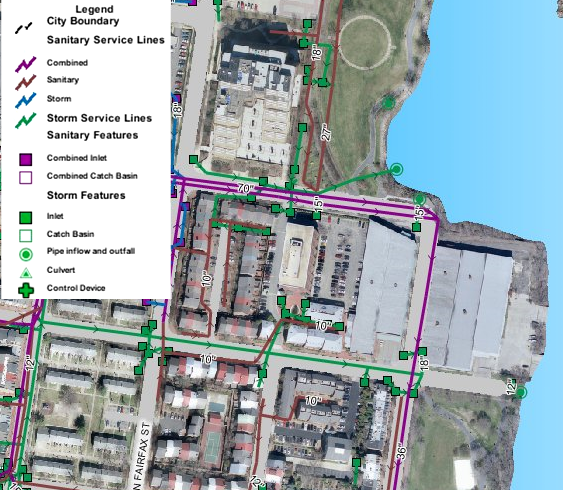
combined pipes (in purple) near CSO-001 outfall at Pendleton Street
Source: Alexandria Sewer Viewer
The 2017 General Assembly was less concerned with Alexandria's financial constraints. The state legislature passed a bill mandating that Alexandria start construction no later than 2023 and eliminate the raw sewage overflows by 2025.11
The bill passed after the environmentally-oriented Potomac Riverkeeper Network allied with conservative Republicans who had no sympathy for the liberal Democratic stronghold, plus some Democrats representing districts downstream from Alexandria. Legislators sympathetic to the city said the bill was "mean spirited and hateful" and designed just to "tar Alexandria."
They argued that the Republican-controlled General Assembly was simply playing partisan politics, citing an original proposal to require compliance by 2020. A former member of the House of Delegates said:12
The city claimed the fastest it could possibly complete construction and stop overflows from the CSO-001 outfall on Pendleton Street was 2028, and requested Democratic Governor Terry McAuliffe to veto or modify the bill. Governor McAuliffe proposed to modify the bill and extend the deadline to complete construction to 2027. That amendment was rejected by the General Assembly in 2017, and the governor then chose to sign the bill rather than to veto it.
As a result, Alexandria was required to meet the deadline of completing construction to bring the CSO-001 outfall into compliance with the Clean Water Act by July 1, 2025. The city chose to construct two underground storage tunnels, using a store-and-treat-later strategy similar to Richmond. The largest infrastructure project in Alexandria's history required demolishing the administrative headquarters building (Building J) at the wastewater treatment plant. That created space for two 12-story deep shafts required to start digging the tunnels, and ultimately for a new pumping station to move effluent from the 120-foot deep tunnels up to the ground-level treatment facility.
Two tunnels were designed to capture and store effluent, and to transport it to the water reclamation plant.
When combined stormwater/sewage flows exceed the capacity of Alexandria ReNew to process wastewater, the excess flows will be diverted into the tunnels rather than through the outfall gates to the Potomac River.
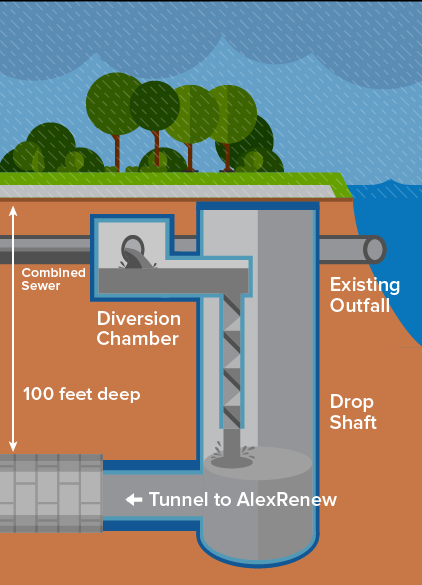
at the four combined stormwater/sewage outlets, excess flows will be diverted into a storage tunnel for later treatment
Source: RiverRenew
When rain stops and stormwater decrease, the combined waste/stormwater will be pumped from the tunnel into the sewers and flow to the Alexandria Renew Water Resource Recovery Facility for treatment.
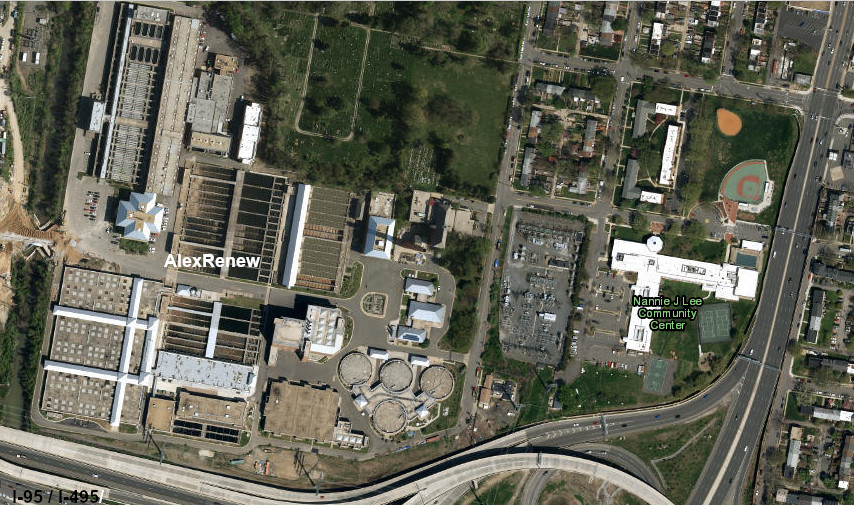
Alexandria will expand storage capacity by constructing underground tunnels to stockpile combined sewage and stormwater
Source: ESRI, ArcGIS Online
The Hooffs Run Interceptor involved expanding an existing pipe from Outfalls 003 and 004 on Hooffs Run. A longer Waterfront Tunnel required boring two miles through the bedrock, a process which was primarily underground and minimized disruption of business activity and traffic in downtown Alexandria.
A tunnel boring machine was required to dig from the wastewater treatment plant first to Outfall 002, which discharged into Hunting Creek at the end of Royal Street. The machine then had to excavate further to reach Outfall 001, which discharged into the Potomac River at the end of Pendleton Street in Oronoco Bay Park.13
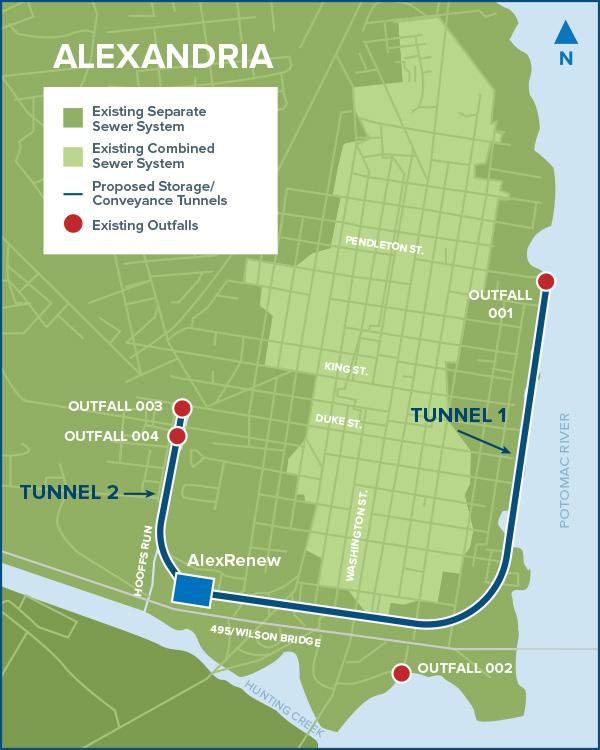
two deep tunnels will connect the four combined stormwater/sewage to Alexandria's water reclamation facility on Cameron Run
Source: RiverRenew
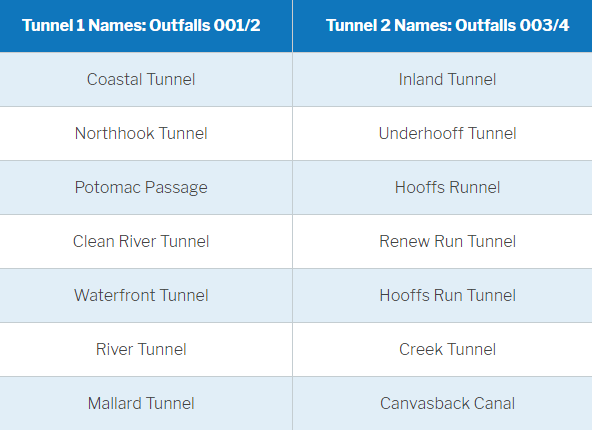
AlexRenew winnowed public suggestions to seven recommended choices for naming each tunnel
Source: RiverRenew
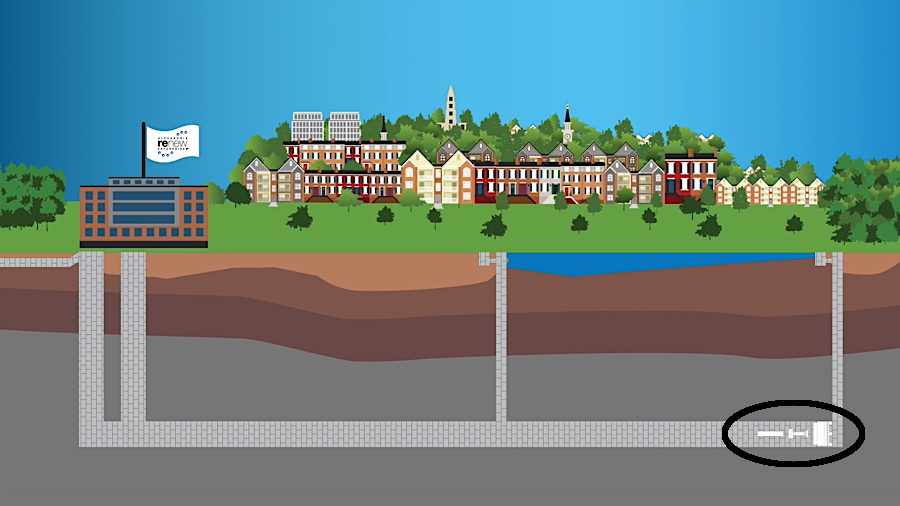
a tunnel boring machine was required to excavate the Waterfront Tunnel, a new interceptor sewer, between the wastewater treatment plant and Outfall 001 in Oronoco Bay Park
Source: Alexandria Renew, Solving a Century-Old Problem with RiverRenew
The Virginia Department of Environmental Quality (DEQ) still allowed the city to plan for a less-than-perfect system. Even after the tunnel storage goes into full operation, Alexandria will discharge combined waste/stormwater through outfall gates an average of four times annually.
That is a substantial reduction from the 60 times annually before the project, but raw waste will still be discharged in the largest storms. The dilution from rainwater will be the greatest during those major storms, so dilution will remain as a partial solution to pollution.
At the time, construction was estimated to cost $356-$534 million. The city planned raise sewer fees 500% in stages to fund the costs.14
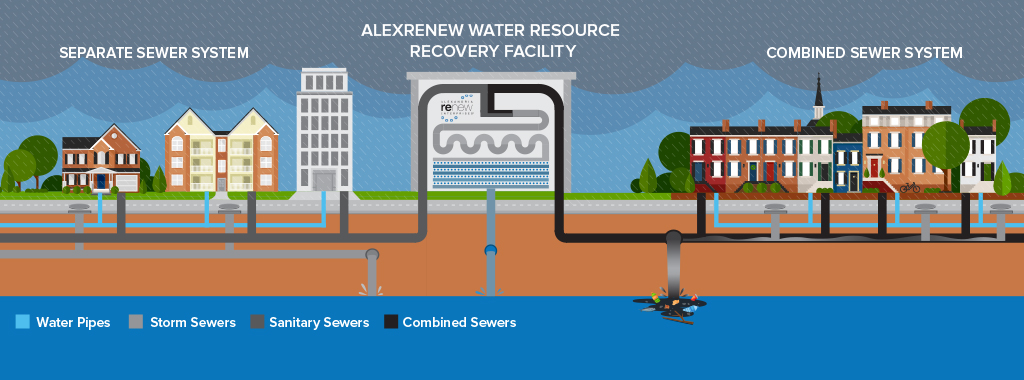
Alexandria has one facility for treating wastewater, plus stormwater from the oldest portion of the city
Source: RiverRenew
To meet the deadlines, the city council transferred ownership of the sewer outlets to its separate wastewater treatment organization, Alexandria Renew, which had more engineering expertise. It titled the initiative "River Renew."
In addition to controlling the outflows from the combined sewer system, Alexandria also had to expand the capacity of its stand-alone stormwater pipes. Many were designed for lower amounts of rainfall than the city was experiencing. The old pipes did not meet the city's standard in 2021 for handling 2.7 inches of rain in one hour, and up to 5.3 inches within 24 hours.
The city initially planned to design the upgrade to accommodate rain events as documented in 2016, an average year at the time. Citizen input caused the city to reassess the plan. The final design of the combined sewer control plan was based on projected precipitation up to the year 2100, taking into account the more-intense rainfall events that were anticipated due to climate change.
The city increased its stormwater budget from less that $30 million per decade to nearly $500 million per decade. The 2019 General Assembly provided $25 million to cover some costs, but costs per house were predicted to rise from $550/year up to as much as $1,030/year in 2025.
Alexandria received a one-time infusion of Federal money in 2021, after Congress passed the American Rescue Plan to spur economic activity and recover from the COVID-19 pandemic. Governor Northam allocated $50 million to Alexandria, along with $50 million to Richmond and $25 million to Lynchburg. Alexandria had requested $500 million, Richmond had requested $833 million, and Lynchburg had requested $25 million after deciding to provide its own $25 million match.
In 2022, city voters approved borrowing $156 million via a bond issue in order to fund upgrades to the Water Pollution Control Plant, plus $50 million more for stormwater improvements. Alexandria retained its AAA bond rating, indicating it had the financial resources to deal with the Combined Sewer Overflow problem.15
Across the river in the District of Columbia, the Environmental Protection Agency also required a reduction in releases of untreated sewage into the Anacostia and Potomac rivers. There were 47 outfalls on the Anacostia River, Potomac River and Rock Creek releasing untreated sewage an average of 74 times/year of average rainfall.
Using the same approach as Richmond and now Alexandria, the District chose to capture the combined sewage and stormwater in 18 miles of giant tunnels excavated in the bedrock before pumping the water to the Blue Plains wastewater treatment plant. The three tunnels were expected to reduce untreated flows by 93% by volume, and to reduce their frequency to 4 times/year.
The cost estimate for the Clean Waters initiative was $2.7 billion, 20% of the local water bill. The third tunnel to be completed, the Potomac Tunnel, would cost $560 million. In 2018, DC Water considered renegotiating its consent decree with the Environmental Protection Agency, but ultimately decided to complete it by 2030 as scheduled.
The Northeast Boundary Tunnel, diverting 98% of combined stormwater/sewage from the Anacostia River, was completed in 2023. The District of Columbia began construction of the Potomac River Tunnel from Georgetown to Blue Plains in 2024. That project was expected to capture 93% of the combined sewer overflow. That percentage would be sufficient for the District to meet Federal water quality standards.16
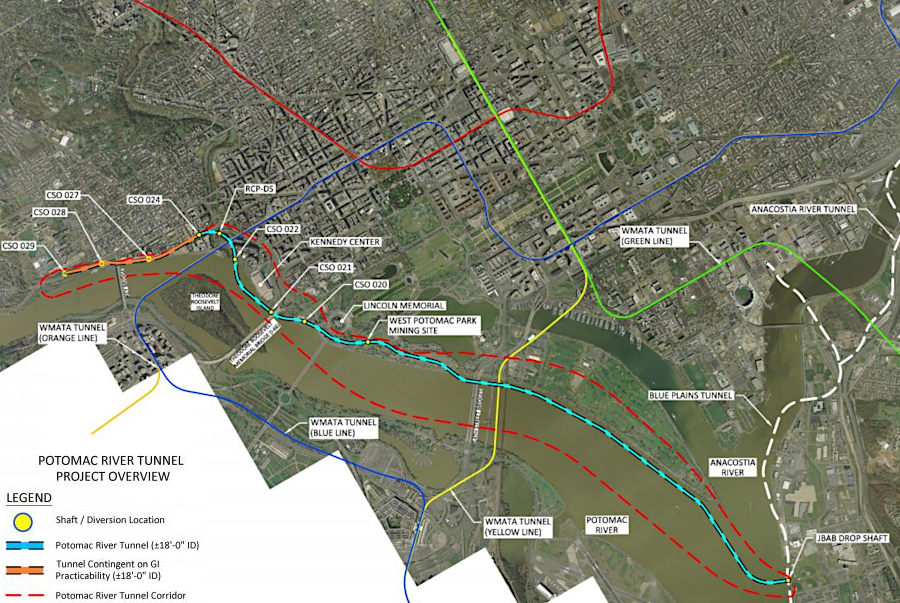
the Potomac River Tunnel is part of DC Water's efforts to reduce Combined Sewer Overflows into the Potomac and Anacostia rivers
Source: DC Water, Potomac River Tunnel
Separating stormwater and sanitary sewer pipes was not a complete cure for pollution; untreated stormwater was still directed to the Potomac River. In 2022, the Potomac Riverkeeper Network sued Alexandria because stormwater was being discharged with excessive levels of polycyclic aromatic hydrocarbons (PAHs).
Stormwater pipes had been installed in the mid-1970's when Alexandria redeveloped the site of its former Alexandria Town Gas manufacturing plant at the end of Orinoco Street. Between 1851-1946 that plant had heated coal in an oxygen-free environment to make methane, and that gas was piped to city houses.
Not all of the coal tar and other residue was removed from the soil when the manufacturing site was redeveloped into townhomes and Founders Park in the late 1970's. Chemical residues seeped into stormwater pipes flowing through city pipes carried which were identified in 1975.
The lawsuit was filed to force the city to take additional remediation actions beyond installing floating booms in the Potomac River to capture the oily sheen that was regularly visible on top of the water, and dredging contaminated sediment from the Potomac River in 2018.
In 2023, the city reached a settlement with the Potomac Riverkeeper Network. The city agreed to install more recovery wells to collect coal tar residues, and to do more to clean up contaminated areas on the land and in river sediments. Alexandria also agreed to contribute $300,000 to the Virginia Department of Wildlife Resources to fund freshwater mussel restoration.
Alexandria had already committed nearly $25 million to minimize the polycyclic aromatic hydrocarbons (PAHs) pollution. A city official said after the settlement:17
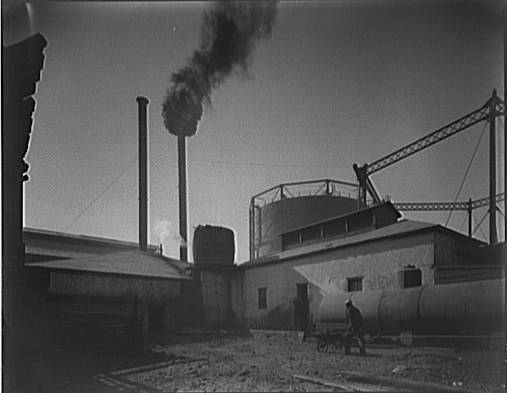
75 years after closure, coal tar residue from the Alexandria Town Gas manufacturing plant was still polluting the Potomac River
Source: Library of Congress, Gas plant. Alexandria City gas plant
The 380-ton tunnel boring machine acquired to excavate the Waterfront Tunnel was named after Hazel Johnson, an environmental justice advocate in Chicago. "Hazel" was dedicated on July 14, 2022. On August 18, the 15-foot-wide, the first part of the 380-ton tunnel boring machine was lowered 138 feet deep into a shaft.
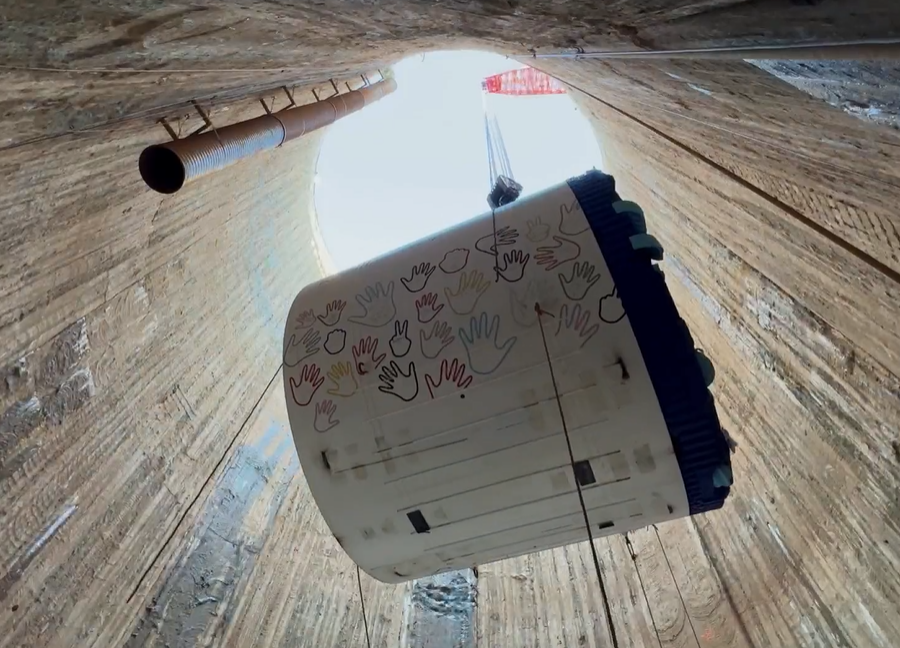
the first part of "Hazel" was lowered down the shaft on August 18, 2022
Source: RiverRenew, Godspeed, Hazel! RiverRenew crews prep our TBM for her big dig (August 22, 2022)
Constructing the 12-foot-wide Waterfront Tunnel, connecting the outfall at the end of North Pendleton Street with the AlexRenew wastewater treatment plant, was scheduled to take 14 months. The tunnel was so long because it was routed underneath the Potomac River between the Woodrow Wilson Bridge and the North Pendleton Street outfall. That route avoided drilling underneath Old Town, reducing the risk that structures on the surface might be impacted by shaking or sunsidence.18
By July 2023, "Hazel" had already drilled 4,000 feet of tunnel and reached Jones Point Park. The tunnel boring machine was scheduled to dig beneath the Potomac River and then turn upstream, in order to reach the planned end point a Oronoco Bay Park.
The machine normally bored for 20 hours each day, and sometimes moved as much as 120 feet in one day. Hazel chewed into the clay nearly 150 feet underground and spit it out the back end of the machine. As one project engineer commented:19
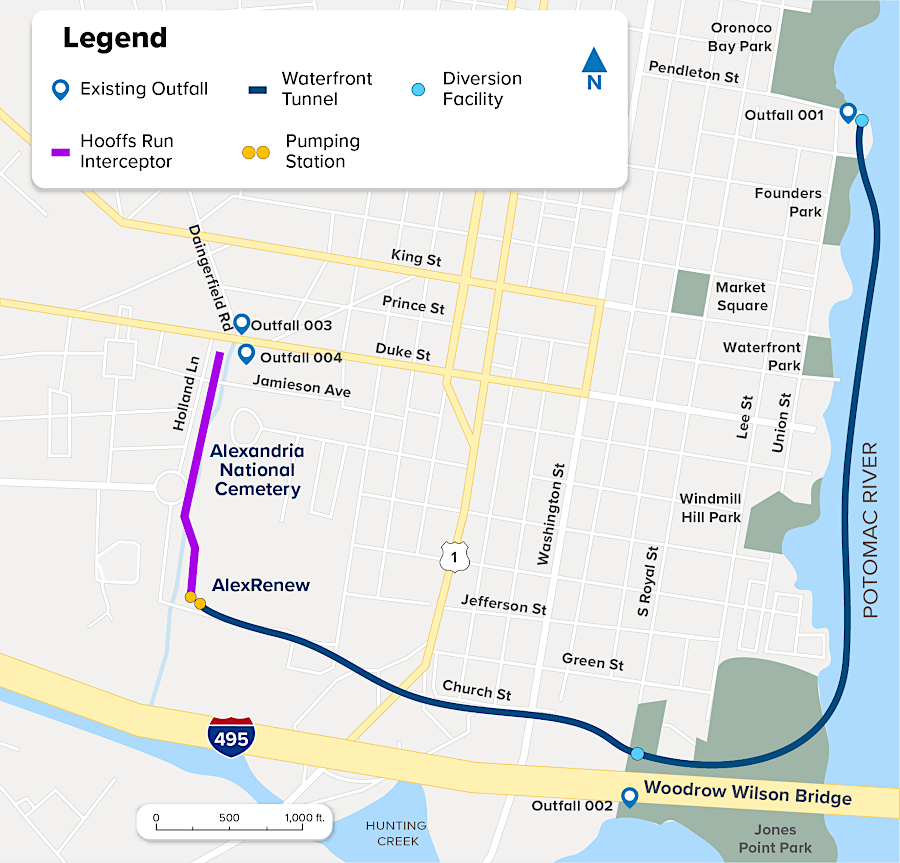
the Waterfront Tunnel was dug below the Potomac River, not underneath Old Town Alexandria
Source: RiverRenew, Alexandria’s Current Combined Sewer System at a Glance (May 30, 2022)
At the start of the 2024 General Assembly, the city requested legislation to extend the completion deadline for one year to July 2026. Delay was blamed on COVID-related supply chain interruption plus the war in Ukraine. The last 2,000 fee of mining by the tunnel boring machine called "Hazel" were predicted to be completed in February 2024.
The costs to expand AlexRenew's wastewater treatment capacity, add pumping stations, and build the tunnel was estimated to exceed $450 million. An additional $40 million in state funding was provided in 2022, and the Environmental Protection Agency approved a $321 million Water Infrastructure Finance and Innovation Act loan and a $50 million American Rescue Plan Act loan.20
As the project neared completion in 2024, final costs were estimated to be $615 million. Bills to AlexRenew ratepayers increased $17-18/month, which was lower than the worst-case projection of a $40/month increase.21
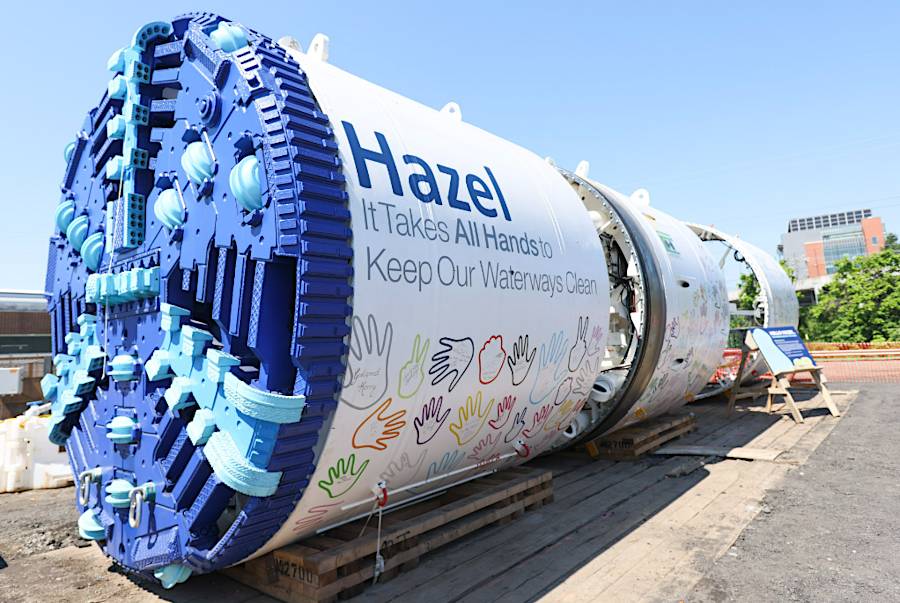
a tunnel boring machine was purchased to excavate the two-mile-long Waterfront Tunnel
Source: Alexandria Renew, TBM Welcome Ceremony - Hazel
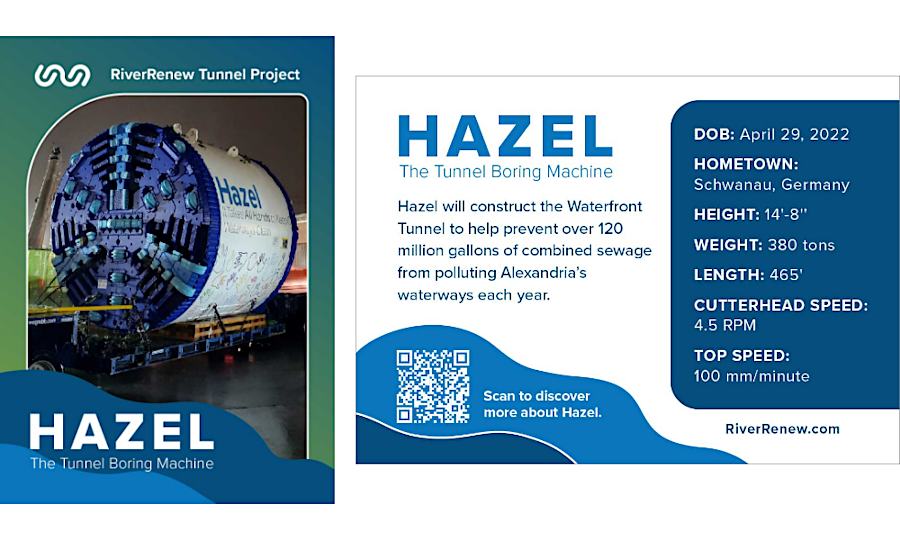
the tunnel boring machine was named after Hazel Johnson, an environmental justice advocate
Source: AlexRenew, Hello, Hazel! AlexRenew Welcomes Our Healthier Waterways Heroine
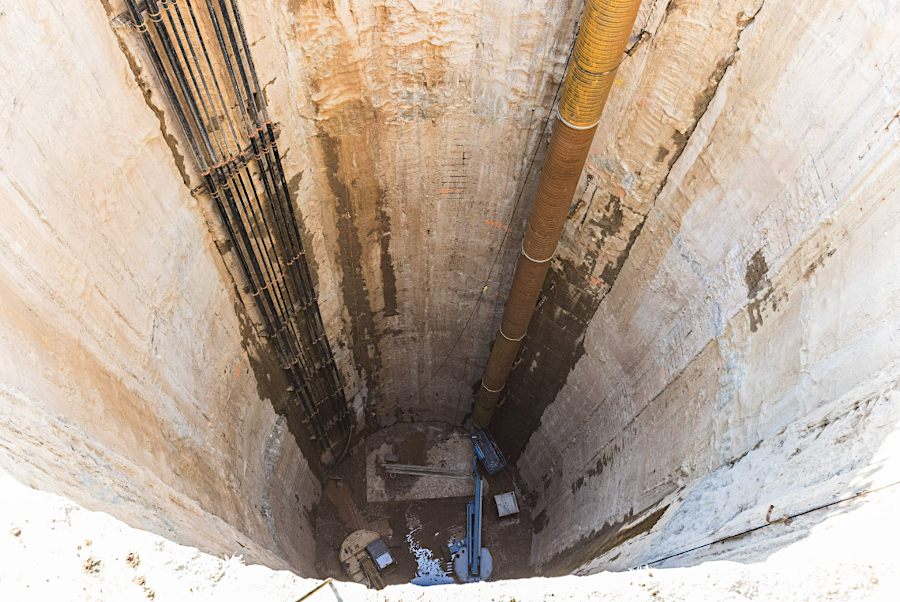
the 380-ton tunnel boring machine was assembled underground, after pieces were lowered through a shaft
Source: AlexRenew, TBM Welcome Ceremony - Hazel
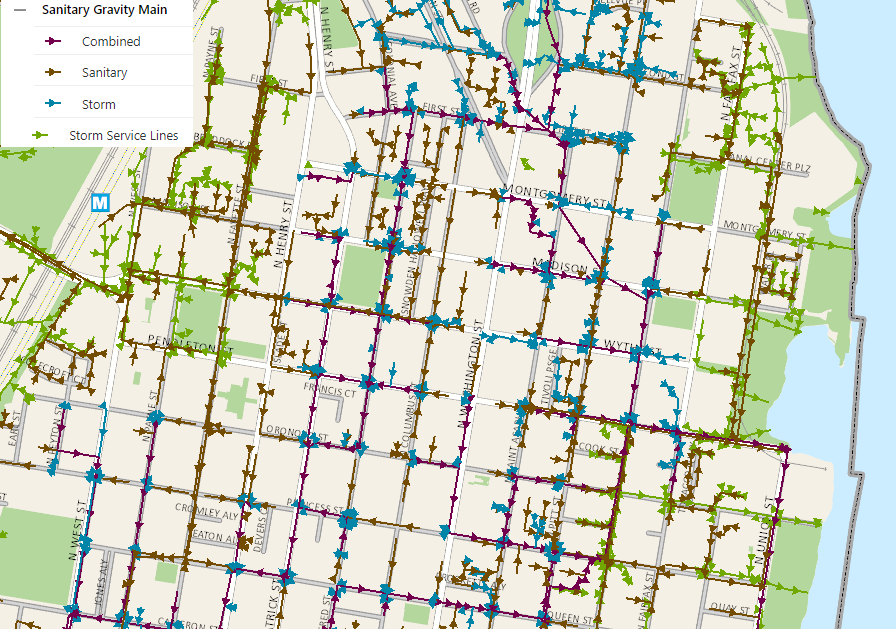
Alexandria has a complicated mix of sanitary, stormwater, and combined sewer pipes
Source: City of Alexandria, Sewer Viewer
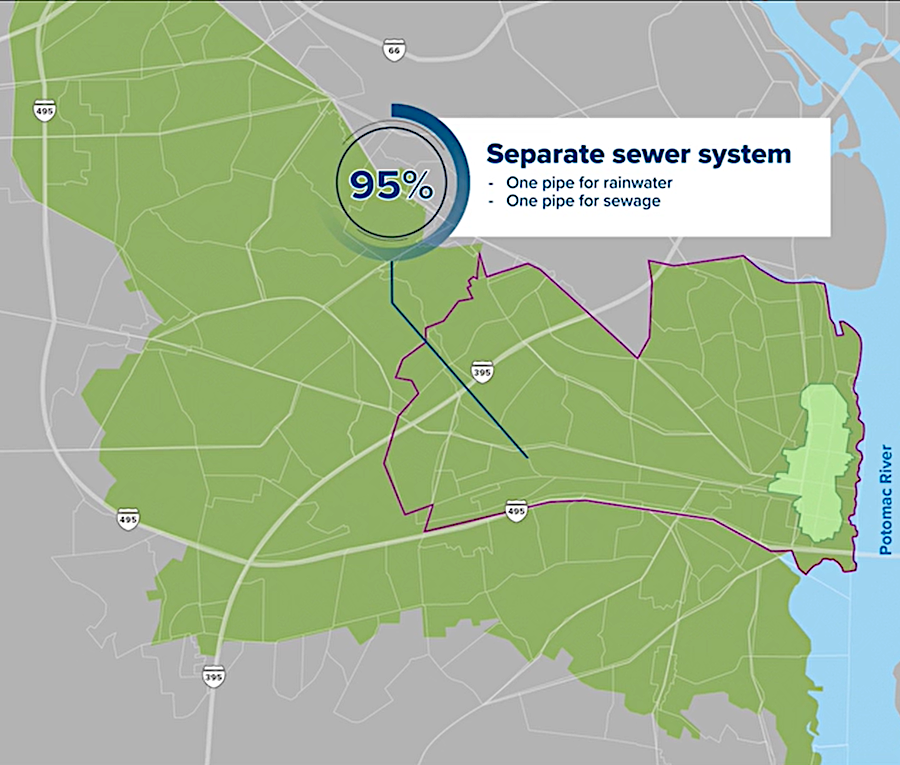
sewer and stormwater pipes are combined in only 5% of the city of Alexandria
Source: Alexandria Renew, Solving a Century-Old Problem with RiverRenew